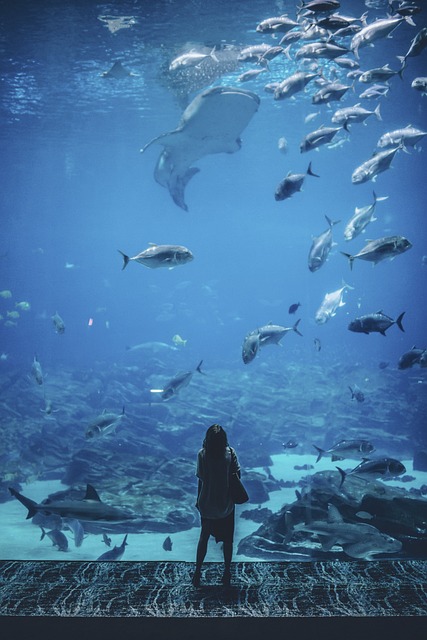Remote-controlled aquariums leverage advanced lighting systems to mimic natural conditions, fostering healthier aquatic ecosystems. These smart lighting solutions offer precise control over spectrum and intensity, enhancing primary production and species behavior. Through smartphone apps, users can customize lighting schedules, color temperatures, and sequences for both functional and aesthetic benefits. Implementing these systems requires understanding species' needs and proper maintenance to ensure optimal water quality and ecosystem health.
Discover how smart lighting systems are transforming aquatic life, offering unprecedented control and benefits. In today’s digital age, remote-controlled aquariums are leading the way in creating dynamic and healthy underwater environments. This article explores the profound impact of lighting on aquatic ecosystems, highlights the advantages of these innovative setups, delves into advanced customization options, and provides best practices for implementation. Optimize your aquarium with smart lighting and witness the breathtaking results.
Understanding the Impact of Lighting on Aquatic Ecosystems
Lighting plays a pivotal role in shaping the health and vibrancy of aquatic ecosystems, from freshwater aquariums to vast marine environments. In the context of remote-controlled aquariums, understanding light’s impact is essential for creating optimal conditions that support diverse species. Different organisms have unique light requirements, ranging from plants needing specific spectrums for photosynthesis to fish and invertebrates being sensitive to light intensity and duration.
Proper lighting management can enhance aquatic life by facilitating primary production in phytoplankton, promoting coral growth, and influencing the behavioral patterns of various species. In remote-controlled aquariums, advanced lighting systems offer precise control over these variables, enabling aquarists to replicate natural conditions or create dynamic environments tailored to specific species’ needs. This technology allows for enhanced observation, research, and conservation efforts in aquatic ecosystems.
The Benefits of Remote-Controlled Aquariums
Remote-controlled aquariums offer a host of benefits for both hobbyists and professionals alike, revolutionizing the way we interact with and care for aquatic life. One of the key advantages is the convenience it provides; users can adjust lighting settings from afar, allowing for precise control over the aquarium’s environment without needing to physically access the tank. This feature is particularly useful for maintaining optimal conditions, especially in larger or more inaccessible aquariums.
Additionally, remote-controlled systems enable easy scheduling of lighting routines, simulating natural day-night cycles and providing a consistent environment for fish and other aquatic creatures. This can significantly enhance their well-being and promote healthy growth patterns. With the ability to customize lighting programs, users can create dynamic displays and even incorporate automated effects, adding an aesthetic touch that captivates viewers while ensuring the aquariums’ ecological balance.
Advanced Features and Customization Options
Smart lighting systems for aquatic environments offer advanced features and customization options that elevate the user experience, especially with remote-controlled aquariums. These systems often come equipped with a range of customizable settings, allowing owners to simulate natural daylight cycles, adjust color temperatures, and even program lighting sequences to create dynamic and immersive underwater landscapes. With just a few clicks on a smartphone app, users can transform their aquariums into captivating displays, catering to both aesthetic preferences and the specific needs of different aquatic species.
Moreover, these advanced systems often incorporate sensors that detect factors like time of day, water temperature, and even the presence of fish or plants in the tank. This data enables automated adjustments to lighting intensity and duration, ensuring optimal conditions for the aquarium inhabitants. Customization options include setting unique schedules, creating custom profiles for different types of aquatic ecosystems, and even synchronizing lights with music or other media, making these smart lighting systems not just functional but also entertaining.
Best Practices for Implementing Smart Lighting in Your Aquarium
Implementing smart lighting for your aquatic ecosystem requires careful consideration and best practices to ensure optimal conditions for aquatic life. Start by understanding the specific needs of your fish and plants. Different species thrive under unique light spectrums, intensities, and durations, so research and plan accordingly. Smart lighting systems offer remote control, allowing precise adjustments throughout the day or even at specific times, mimicking natural sunlight patterns. This is particularly beneficial for remote-controlled aquariums where manual access is limited.
Placement of lights within the aquarium is crucial. Positioning them correctly ensures uniform illumination across all zones, catering to both plants and fish. Additionally, consider using dimmable smart bulbs or control the lighting intensity to replicate natural transitions, promoting healthier growth and behavior in your aquatic inhabitants. Regular maintenance and scheduling are key; set routines for light cycling and ensure regular cleaning to maintain water quality and clarity, enhancing the overall health of your remote-controlled aquariums ecosystem.
Smart lighting systems, coupled with the advanced features of remote-controlled aquariums, offer a new level of customization and care for aquatic life. By understanding the impact of lighting on these ecosystems and implementing best practices, aquarists can create dynamic and healthy environments for their fish and plants. The ability to remotely control lighting conditions allows for efficient management, making it easier than ever to maintain vibrant, bustling aquariums.
